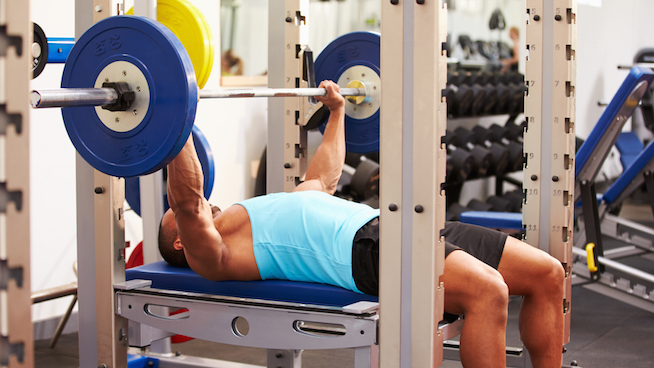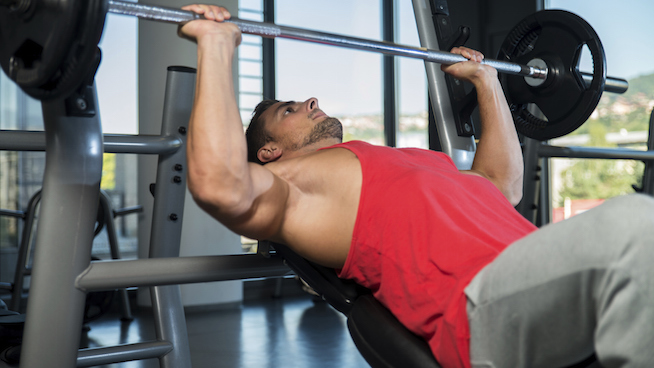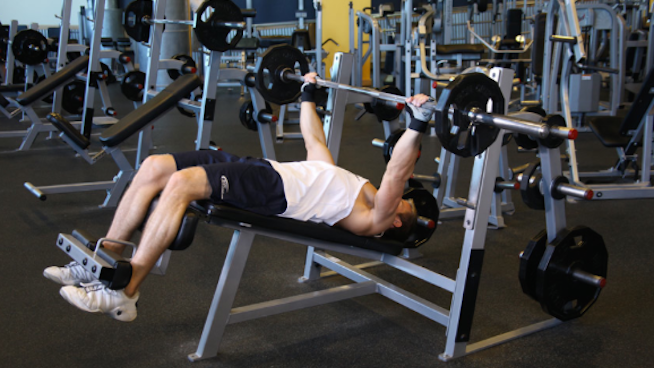Bench Press Breakdown: The Flat, Incline and Decline
What’s the biggest fear of average gym-goers? Embarrassing themselves. Everyone likes to come off as an all-knowing weight room warrior, and no one wants to be the clueless person who has no idea how to work out. This unfortunate phenomenon leads to some simple questions going unasked.
For example—what’s the difference between the Incline, Decline and Flat Bench Press? It’s a simple question regarding variations of a popular exercise, but odds are you don’t know the answer. Until now.
Flat Bench Press
The Flat Bench Press (also known as the traditional or the standard Bench Press) serves as the baseline. It’s what you think of when you picture someone performing the exercise—a lowering and pressing movement with your back on a bench that’s parallel to the ground.
The major muscle group targeted by the Flat Bench Press is the pectoralis major, also known simply as the “pecs.” This is the largest muscle group in the chest and is very important for pushing movements.
The Flat Bench Press does a great job of targeting both the upper and lower pecs, a.k.a. the “clavicular” and “sternocostal” heads. It also hits the triceps brachii and the anterior deltoids. It’s a solid upper-body exercise, albeit one that can be a tad risky for the shoulders if done with improper form.
RELATED: How to Fix 3 Common Bench Press Form Mistakes
Incline Bench Press
The Incline Bench Press differs from Flat Bench Press in that the bench itself is raised—or “inclined”—to a higher angle, anywhere from 15 to 50 degrees.
Compared to the Flat Bench Press, the Incline Bench Press more heavily targets the upper portion of the pecs (the clavicular head) and the anterior deltoids (the area between the pecs and the front of the shoulders). The difference is not drastic, but the Incline Bench Press is great for strengthening these sometimes-hard-to-target muscle groups.
You probably won’t be able to bench as much weight on the Incline as you can on the traditional Bench Press, but don’t be discouraged. This is to be expected due to the mechanical differences between the two movements. For some athletes, such as football lineman, who must come out of their stance and hit on the rise, the angle of the Incline Bench Press could translate better to sports movements than the Flat Bench Press.
The higher the incline of the bench, the more the exercise targets your shoulders and deltoids. But if you jack the incline up too far, you’d probably be better served by doing a traditional shoulder-centric exercise like the Dumbbell Shoulder Press.
In terms of injury risk, the Incline Bench Press (when performed correctly) is generally considered a bit riskier than the traditional Bench. The angle of the exercise puts significantly more stress on your shoulders and rotator cuffs, which could be problematic for overhead athletes like baseball pitchers and quarterbacks.
RELATED: UCLA Football on Properly Performing an Incline Bench Press
Decline Bench Press
The Decline Bench Press is the most mysterious of the three exercises. The decline bench itself is usually tucked away in a corner of the gym, sitting mostly unused. Occasionally, some dude saunter overs, loads up the bar and performs a few sets, but few people understand the purpose of the exercise.
The Decline Bench Press differs from the traditional Bench Press in that the bench has been lowered—or “declined”—to a lower angle, typically between 15 and 30 degrees.
A key attribute of the Decline Bench Press is that it targets the bottom portion of the lower pec more efficiently than either the Flat or the Incline Bench Press.
Generally speaking, athletes can lift more weight on the Decline Bench Press than on either the Flat or the Incline Bench. One study found that participants’ one-rep max for the Decline was 1.25 times their body weight, compared to 1.07 for the Incline. For an 180-pound athlete, that translates to a difference of nearly 33 pounds.
The Decline Bench Press is considered a bit safer than both the traditional and the Incline Bench Press, since it moves stress off the shoulders and places it more on the lower pecs.
These sound like intriguing benefits, but the truth is that athletes probably shouldn’t waste their time on the Decline Bench Press.
RELATED: 15 Advanced Push-Up Exercises
Its biggest benefit is the increased muscle activation at the bottom portion of the pecs, but that’s mostly a superficial muscular area. It might make sense for bodybuilders, but athletes focused on improving their sports performance have better ways to spend their training time.
The Verdict
The traditional Bench Press is one of the most popular exercises in existence and has spawned many variations. The Incline Bench Press is worthy of inclusion in many athletes’ routines, because it efficiently targets the upper pecs and anterior deltoids. However, if you have shoulder issues, you might be better off staying away from the Incline Bench Press.
Although the Decline Bench Press effectively targets the lower part of the pecs and places less stress on the shoulders, it probably isn’t worth your time unless you’re a bodybuilder. It’s largely a superficial exercise, and regularly including it in your routine makes little sense if you’re focused on becoming a better athlete.
It’s hard to say that either variation beats the traditional Bench Press in terms of overall usefulness. A better choice than either of them is the Standing Cable Chest Press. It puts you in a more athletic position (on your feet instead of on your back), which translates better to on-field performance, and it’s a very low risk movement.
RECOMMENDED FOR YOU
MOST POPULAR
Bench Press Breakdown: The Flat, Incline and Decline
What’s the biggest fear of average gym-goers? Embarrassing themselves. Everyone likes to come off as an all-knowing weight room warrior, and no one wants to be the clueless person who has no idea how to work out. This unfortunate phenomenon leads to some simple questions going unasked.
For example—what’s the difference between the Incline, Decline and Flat Bench Press? It’s a simple question regarding variations of a popular exercise, but odds are you don’t know the answer. Until now.
Flat Bench Press
The Flat Bench Press (also known as the traditional or the standard Bench Press) serves as the baseline. It’s what you think of when you picture someone performing the exercise—a lowering and pressing movement with your back on a bench that’s parallel to the ground.
The major muscle group targeted by the Flat Bench Press is the pectoralis major, also known simply as the “pecs.” This is the largest muscle group in the chest and is very important for pushing movements.
The Flat Bench Press does a great job of targeting both the upper and lower pecs, a.k.a. the “clavicular” and “sternocostal” heads. It also hits the triceps brachii and the anterior deltoids. It’s a solid upper-body exercise, albeit one that can be a tad risky for the shoulders if done with improper form.
RELATED: How to Fix 3 Common Bench Press Form Mistakes
Incline Bench Press
The Incline Bench Press differs from Flat Bench Press in that the bench itself is raised—or “inclined”—to a higher angle, anywhere from 15 to 50 degrees.
Compared to the Flat Bench Press, the Incline Bench Press more heavily targets the upper portion of the pecs (the clavicular head) and the anterior deltoids (the area between the pecs and the front of the shoulders). The difference is not drastic, but the Incline Bench Press is great for strengthening these sometimes-hard-to-target muscle groups.
You probably won’t be able to bench as much weight on the Incline as you can on the traditional Bench Press, but don’t be discouraged. This is to be expected due to the mechanical differences between the two movements. For some athletes, such as football lineman, who must come out of their stance and hit on the rise, the angle of the Incline Bench Press could translate better to sports movements than the Flat Bench Press.
The higher the incline of the bench, the more the exercise targets your shoulders and deltoids. But if you jack the incline up too far, you’d probably be better served by doing a traditional shoulder-centric exercise like the Dumbbell Shoulder Press.
In terms of injury risk, the Incline Bench Press (when performed correctly) is generally considered a bit riskier than the traditional Bench. The angle of the exercise puts significantly more stress on your shoulders and rotator cuffs, which could be problematic for overhead athletes like baseball pitchers and quarterbacks.
RELATED: UCLA Football on Properly Performing an Incline Bench Press
Decline Bench Press
The Decline Bench Press is the most mysterious of the three exercises. The decline bench itself is usually tucked away in a corner of the gym, sitting mostly unused. Occasionally, some dude saunter overs, loads up the bar and performs a few sets, but few people understand the purpose of the exercise.
The Decline Bench Press differs from the traditional Bench Press in that the bench has been lowered—or “declined”—to a lower angle, typically between 15 and 30 degrees.
A key attribute of the Decline Bench Press is that it targets the bottom portion of the lower pec more efficiently than either the Flat or the Incline Bench Press.
Generally speaking, athletes can lift more weight on the Decline Bench Press than on either the Flat or the Incline Bench. One study found that participants’ one-rep max for the Decline was 1.25 times their body weight, compared to 1.07 for the Incline. For an 180-pound athlete, that translates to a difference of nearly 33 pounds.
The Decline Bench Press is considered a bit safer than both the traditional and the Incline Bench Press, since it moves stress off the shoulders and places it more on the lower pecs.
These sound like intriguing benefits, but the truth is that athletes probably shouldn’t waste their time on the Decline Bench Press.
RELATED: 15 Advanced Push-Up Exercises
Its biggest benefit is the increased muscle activation at the bottom portion of the pecs, but that’s mostly a superficial muscular area. It might make sense for bodybuilders, but athletes focused on improving their sports performance have better ways to spend their training time.
The Verdict
The traditional Bench Press is one of the most popular exercises in existence and has spawned many variations. The Incline Bench Press is worthy of inclusion in many athletes’ routines, because it efficiently targets the upper pecs and anterior deltoids. However, if you have shoulder issues, you might be better off staying away from the Incline Bench Press.
Although the Decline Bench Press effectively targets the lower part of the pecs and places less stress on the shoulders, it probably isn’t worth your time unless you’re a bodybuilder. It’s largely a superficial exercise, and regularly including it in your routine makes little sense if you’re focused on becoming a better athlete.
It’s hard to say that either variation beats the traditional Bench Press in terms of overall usefulness. A better choice than either of them is the Standing Cable Chest Press. It puts you in a more athletic position (on your feet instead of on your back), which translates better to on-field performance, and it’s a very low risk movement.













